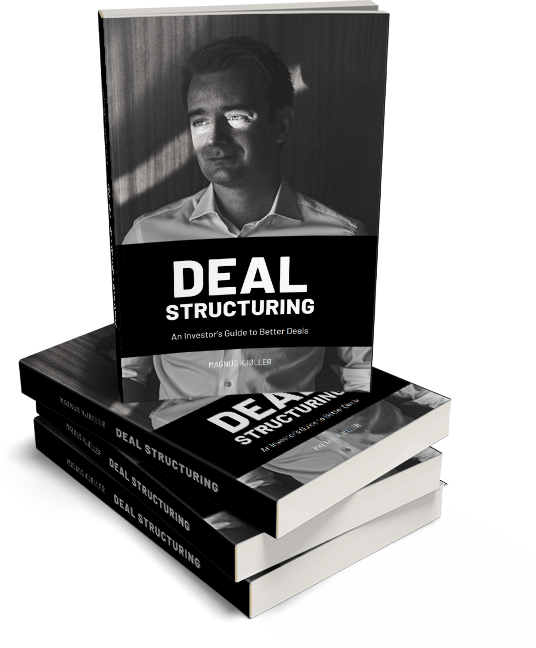Question & Answer
What Are the Most Common Deal Structures?

The structure of the deal is just as important as the valuation or ownership percentage. The right structure balances risk, reward, and alignment between founders and investors.
There isn’t a one-size-fits-all approach. Some deals are straightforward, while others blend multiple elements to create a tailored arrangement. At Kjøller, we work with all types of investment structures and often combine them to fit the needs of both parties.
Let’s explore the most common deal structures in startup investments.
Cash for Equity – The Classic Model
Cash-for-equity is the simplest and most well-known structure. Investors provide capital in exchange for a percentage of ownership in the company.
Why it’s popular:
- Easy to understand and execute.
- Gives investors direct ownership in the company.
- Aligns interests between investors and founders.
Challenges:
- Requires a valuation agreement upfront, which can be difficult for early-stage startups.
- Dilutes the ownership of founders and existing shareholders.
Despite its simplicity, a well-structured cash-for-equity deal can include additional terms such as liquidation preferences, voting rights, and dividend structures to protect investors.
Convertible Notes – Flexibility with a Future Valuation
Convertible notes are a hybrid between debt and equity. Instead of pricing the startup immediately, investors provide a loan that converts into equity in a future funding round.
Why investors like them:
- Postpones the valuation discussion until the next round, reducing risk.
- Often includes an interest rate and a discount on future shares.
- Gives investors downside protection if the company fails.
Downsides:
- Can create complex cap table issues if not structured properly.
- Founders risk accumulating too much convertible debt before conversion.
These are particularly common in seed rounds where valuation discussions can be premature.
SAFEs – The Rising Alternative
Simple Agreements for Future Equity (SAFEs) are similar to convertible notes but without the debt component. Instead of being a loan, a SAFE gives investors the right to purchase equity at a future funding round.
SAFEs are gaining traction globally, but adoption is still country-specific due to regulatory differences.
Benefits:
- Faster and cheaper to execute than convertible notes.
- No interest or maturity date, which reduces pressure on founders.
- Provides flexibility for early-stage companies.
Challenges:
- Can lead to unexpected dilution if multiple SAFEs convert at different terms.
- Some investors prefer the protection of a convertible note’s debt structure.
SAFEs are widely used in startup hubs like the US, but investors in other markets may still prefer more traditional structures.
Revenue-Based Financing – Growth Without Dilution
Instead of giving up equity, some startups raise money through revenue-based financing. Investors provide capital in exchange for a percentage of future revenue until a predetermined return is met.
Why it’s attractive:
- Founders retain full control of the company.
- No valuation negotiation needed.
- Suitable for businesses with predictable revenue.
Challenges:
- Not ideal for high-burn startups that won’t generate revenue immediately.
- Payments reduce cash flow, which can impact growth.
This structure is particularly useful for SaaS and e-commerce startups with strong recurring revenue models.
Venture Debt – Adding Leverage to Equity Rounds
Venture debt is a loan given to startups, often alongside an equity round. It allows companies to raise additional funds without giving up more ownership.
Benefits:
- Extends runway without immediate dilution.
- Can be cheaper than raising more equity.
- Often comes with flexible repayment structures.
Risks:
- Requires repayment, which adds financial pressure.
- Some lenders include covenants that restrict company operations.
Venture debt is commonly used by startups with strong revenue streams looking to scale without raising a full-priced equity round.
How we do it at Kjøller
At my investment firm Kjøller, we rarely rely on just one investment structure. Instead, we tailor each deal using a combination of cash-for-equity, convertible instruments, revenue-based components, options and structured exits to align incentives and mitigate risk.
By mixing structures, we can create deals that benefit both investors and founders, ensuring fair terms while keeping long-term interests aligned.
As covered in Deal Structuring, understanding different investment models and combining them effectively can make all the difference in securing the right deal.

Deal Structuring
Buy the book today and dive into practical techniques that empower you to get started immediately, navigating transactions efficiently and maximizing your success in minimizing cash requirements.
In this book, you will:
- Be introduced to the fundamentals of deal structuring
- Learn 19 proven deal models for structuring deals
- Discover 39 key elements of deal nuances
- Access 32 actionable clauses for your term sheets
- Explore 9 specific deal structures
- Receive 257 pages of invaluable insights
- Gain the distilled expertise of 20 years